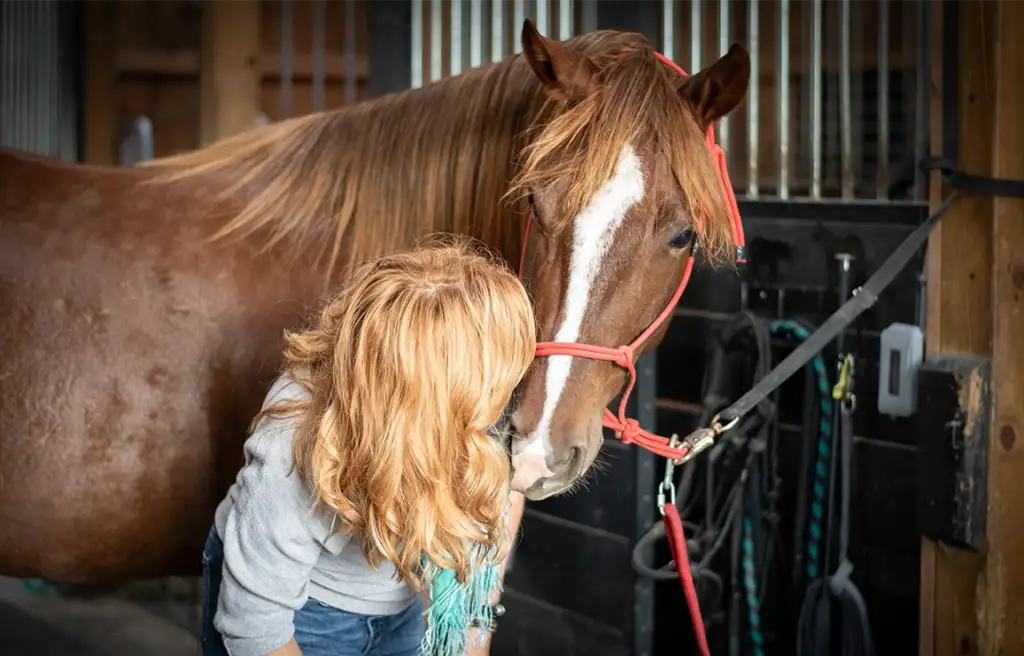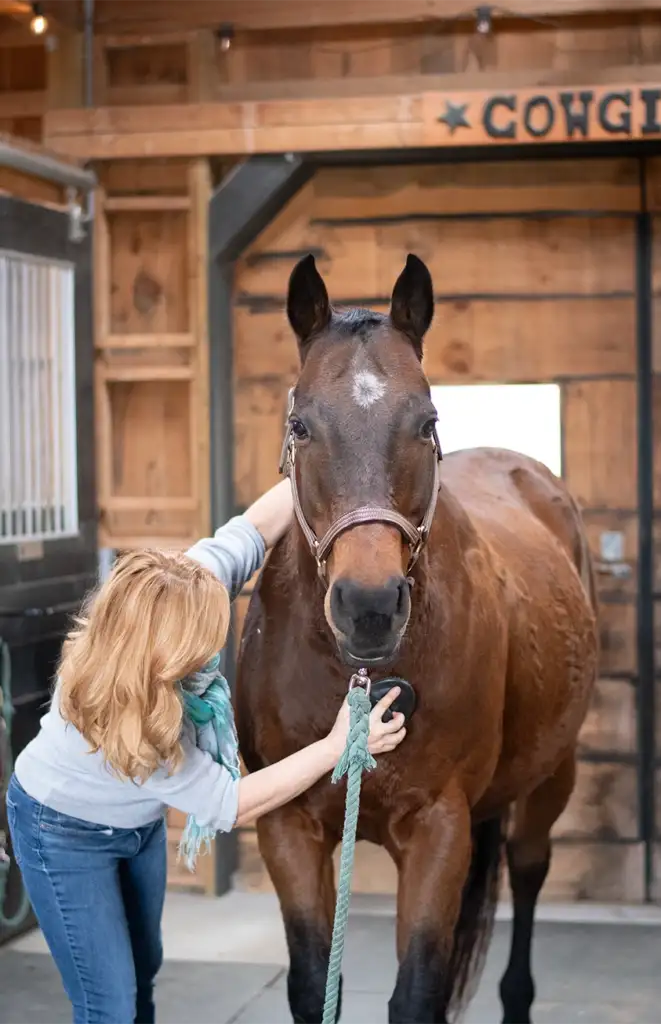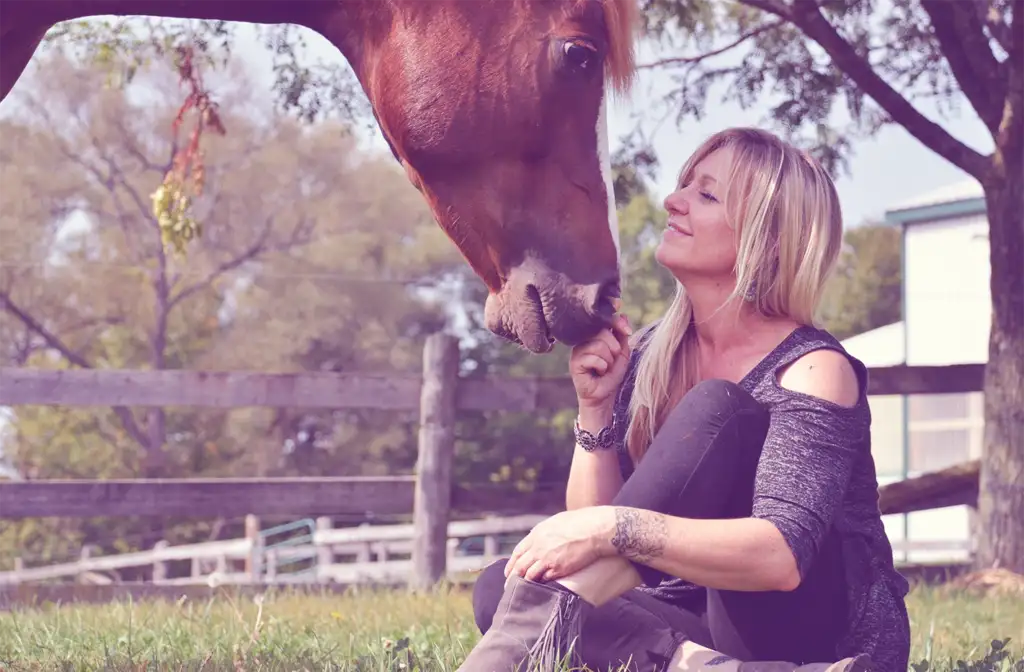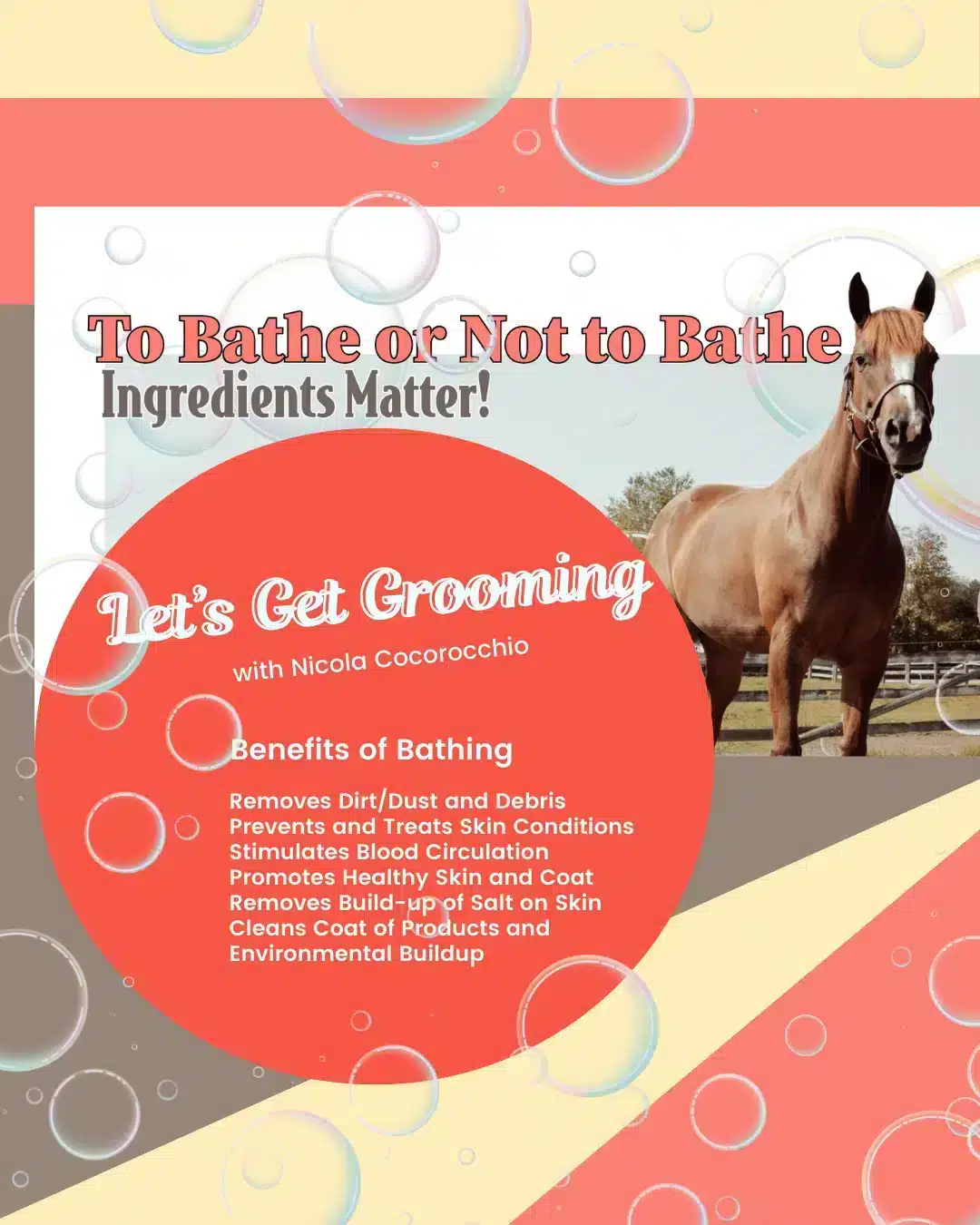As a beauty professional and product expert, I am an avid groomer! I love keeping my horses’ skin and coat in tip-top condition. One of the ways I do this is by bathing them. After all, the skin is the largest organ. It’s the body’s protective super shield, and I want to keep my horse’s skin and coat healthy.
Before we decide to bathe, there is some important information we need to know: what shampoos and conditioners are best? Do the ingredients matter? And why is the pH of our products important? As with most things, there are many opinions on bathing horses. Ultimately, I think, it depends on your horse’s lifestyle. What kind of work do they do? Do they sweat a lot? Do you use a lot of coat sprays (fly spray, conditioning sprays and oils, etc.) that can build up on the hair and skin? Do they suffer from any type of skin condition that could be irritated by a bath? Or maybe a bath might help to treat and soothe a skin issue. If you are unsure, you can always consult your veterinarian. Especially if your horse has any kind of skin condition or concern.

Editor’s Choice
One of the main reasons for keeping your horse clean is riding. Tacking up a clean horse, free of dirt and dust, is imperative. This will ensure that the area where the saddle sits is clean. Excess dirt or debris could cause irritation where the tack comes into contact with the skin. Bathing also helps to remove pathogens (germs) that can cause skin issues and infections. Stimulating circulation helps to promote hair growth, healthy skin, and a shiny coat. Dried sweat left on a horse can cause chafing, itching, fungus, and possibly infections.
Benefits of Bathing
- Removes Dirt/Dust and Debris
- Prevents and Treats Skin Conditions
- Stimulates Blood Circulation
- Promotes Healthy Skin and Coat
- Removes Build-up of Salt on Skin
- Cleans Coat of Products and Environmental Buildup
Lastly, if you use a lot of grooming products, they may contain ingredients that could build up on the hair and skin, causing dandruff and itching. This will leave the coat dull and dry. Keeping a horse’s coat clean and properly conditioned keeps it shiny and healthy and allows it to perform the way it’s supposed to. Choosing products for bathing your horse is probably as daunting as choosing the right hair products for yourself. The shelves are full of all kinds of shampoos and conditioners and serums and sprays, just as they are at a hair salon. I have been in the beauty industry for over 30 years, and I will tell you what I tell my clients every day… ingredients matter!

Below are ingredients easily found in many products that I try (if possible) to avoid for both people and equines; some of these ingredients you will probably already know.
The Avoid if Possible List
- Parabens – Chemical Preservatives
- Sulfates – Detergents
- Phthalates – Gelling Agents
- Silicones – Chemical Sealants
- Chemical Sunscreens – Just What It Says
- Dyes – Cosmetic, Artificial Colors
- Fragrance – Usually Artificial and Chemical
- Synthetic Polymers – Thickening Agents
In my line of work, these ingredients most commonly cause allergic reactions, dermatitis, eczema, and dry and damaged hair. When my heart horse, Milly, was diagnosed with kidney disease in 2017, I wanted to do everything I could to not stress her kidneys further. I became vigilant about what went on her body. Sadly, Milly has passed on, but my other horses now benefit from what my journey with Milly has taught me.

Choosing quality products when grooming your horses, to me, is very important. There are some smaller, boutique-style companies out there trying to offer better, safer, more natural choices for us. They tend to cost a little bit more but are usually more concentrated, so you can use a little less. If you can’t find what you are looking for in-store, you can do what I do and make your own. It sounds scary, I know… But it’s actually easier than you may think. Something to keep in mind when making a “natural” shampoo at home is that it won’t lather the way a store-bought shampoo does, and that’s okay. It doesn’t have to be cleaned later. I make my horse shampoo “soap-free” if I am bathing more regularly. I don’t want to strip the coat of its natural oils.
Soap-Free Shampoo
- 1 can, Full Fat Coconut Milk
- 2 tbs raw honey
- 1 tsp topical castor oil
- 1 tsp avocado oil (or jojoba oil)
- 2 tbs apple cider vinegar
- 8 drops of lavender oil
- 8 drops rosemary oil
- 8 drops chamomile oil
Whisk ingredients together in a bowl until smooth. Transfer to a clean squeeze bottle and shake well. This no-lather “shampoo” is a nutrient-rich cleanser for your horse’s hair and skin.
The full-fat coconut milk is a super-rich moisturizer full of natural fatty acids. Raw honey is nature’s humectant (adds moisture).
Honey naturally smooths the hair, restoring shine.
Castor oil is praised for its anti-inflammatory properties and is also used as an anti-fungal and antibacterial oil. It will prevent dandruff and soothe dry, flaky skin.
Avocado oil is rich in magnesium and vitamins like biotin, all of which boost shine and elasticity and prevent breakage.
Apple cider vinegar is a great antioxidant; it will help neutralize free radicals and break down fungus and bacteria on the skin. I prefer to use Young Living Essential Oils on my horses because of the quality and authenticity of the oils and their unique Seed to Seal process.
I add lavender oil because it softens and nourishes hair. Rosemary oil works to reduce damage and breakage, making hair stronger.
And finally, chamomile oil calms and soothes the skin, leaving the coat with incredible shine. I try to use up all of my soap-free shampoo, but if you don’t, it should last about a week if refrigerated.
If you prefer a shampoo that lathers, you will need to purchase a bottle of Castile soap. This versatile, plant-based soap is free of animal fats and synthetic ingredients. Castile soap is non-toxic and biodegradable. It comes in liquid form, so you can substitute 1 cup of Castile soap and 1 cup of distilled water for the coconut milk in the above recipe. Before bathing, we need to talk about the importance of the pH (potential of hydrogen) of the products we are using on our horses.
Just like our hair and skin care products, our horses’ products should also be pH balanced. pH refers to the acidity or alkalinity of a substance and is measured on a scale of 0–14. A pH of 7 is regarded as neutral. The healthy pH for our hair and skin is 4.7–5.8, slightly acidic. For horses, their pH is much closer to neutral, 7.0–7.4. Therefore, it is not a good idea to use human shampoo (usually pH balanced to 4.5-5.5) for bathing our horses, and vice versa. Horse shampoo is not ideal for our hair, especially if your hair is colour-treated. The higher pH will gradually strip out your colour. Products with too low or too high of a pH can damage the hair and dry out the skin. Acidic (low pH) products make the cuticle contract and over time will cause dryness. Alkaline (high pH) products cause the cuticle to open and will leave the hair frizzy and dry and unable to hold moisture. Any conditioners you use will just rinse away. Staying pH balanced is very important to hair and skin health for horses and ourselves.
If you choose not to bathe, and that’s fine, your grooming routine and the quality of the brushes you choose become very important. Remember that inspecting, cleaning, and maintaining brush health can impact your horse and the quality of your groom. I hope this helps answer the question, “To Bathe or Not to Bathe?” For me, it’s always about what’s best for each one of my horses. What’s good for one might not be good for another. Just like the clients that sit in my chair.
Article by Nicola Cocorocchio, Photography provided by Nicola Cocorocchio
Nicola Cocorocchio, MMCP Equi-Verde Therapies Canadian Advisor, Healing Barn Movement [email protected]









